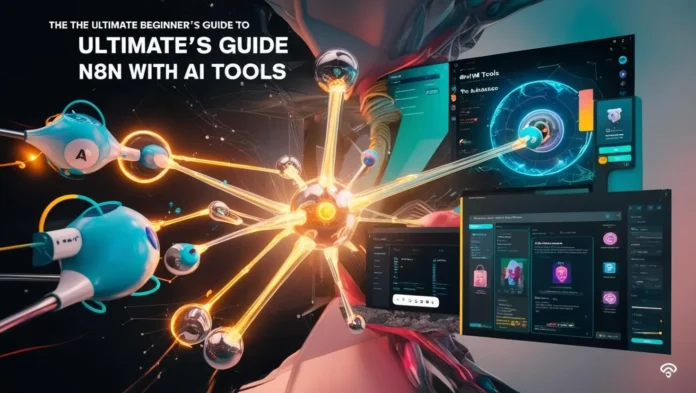In the age of automation and AI, tools like n8n offer an accessible and flexible way to integrate multiple AI platforms—without writing code. This guide is designed for beginners who want to automate AI workflows by connecting services like OpenAI, Hugging Face, and more using n8n’s visual, no-code interface.
Whether you’re building chatbots, automating content creation, or handling intelligent notifications, n8n gives you full control over your AI-driven logic. In this in-depth guide, you’ll not only understand what n8n is and how it works, but also how it transforms AI workflows into seamless automation systems.
Contents
- 1 What is n8n?
- 2 Why Use n8n for AI Workflows?
- 3 How n8n Works
- 4 Example Use Cases of n8n + AI
- 5 Step-by-Step Tutorial: Automate AI Text Generation with OpenAI
- 6 Best Practices for AI Automation in n8n
- 7 Security & Privacy Considerations
- 8 Real-World Workflow Examples
- 9 Final Thoughts
- 10 Internal Links
- 11 Outbound Links
What is n8n?
n8n (“nodemation”) is an open-source workflow automation tool that allows users to connect different apps and APIs with simple drag-and-drop flows. Unlike closed-source tools, n8n offers flexibility, privacy, and customization. It supports over 300 native integrations and provides endless flexibility via HTTP and Function nodes.
n8n is particularly powerful when used in combination with AI tools because it enables users to design end-to-end workflows—triggered by events or schedules—that can take in data, process it through AI models, and return results in real-time.
Why Use n8n for AI Workflows?
- No-Code/Low-Code: Ideal for non-developers who want to use AI tools.
- Multi-Service Integration: Easily connect with OpenAI, Hugging Face, Replicate, Stability AI, and more.
- Fully Customizable: Add logic, conditions, and branching workflows for more complex scenarios.
- Self-Hosted Option: Run your workflows on your own server to ensure data privacy and full control.
- Community Support: A large and active community provides templates, nodes, and ideas.
How n8n Works
Each automation in n8n is a workflow made up of nodes. Nodes can represent:
- Triggers (e.g., HTTP Webhook, Schedule, or form submission)
- Data inputs (e.g., Google Sheets, Airtable)
- AI model calls (e.g., OpenAI, Hugging Face API)
- Data processors (e.g., Function node for JS logic)
- Outputs (e.g., email, CMS, Discord, Slack)
n8n uses a simple visual interface that lets users drag and drop nodes, configure parameters, and connect flows together.
Example Use Cases of n8n + AI
- Automated Article Generation
Use a Google Sheet to hold article prompts, send them to OpenAI via n8n, then post the generated content to your WordPress blog. - Customer Support Assistant
Build a chatbot using OpenAI and connect it to your support ticket system via n8n. It reads customer inquiries and suggests automated replies. - Sentiment Analysis from Reviews
Extract product reviews from your e-commerce platform, send them to Hugging Face for sentiment analysis, and log results to a database. - Automated Image Captioning
Upload images to a Google Drive folder, process them via Replicate or Hugging Face’s image models, and get AI-generated captions.
Step-by-Step Tutorial: Automate AI Text Generation with OpenAI
1. Trigger Setup
Use the Webhook node to create a public endpoint, or use the Schedule node to run the workflow at set times.
2. Collect Input Data
Pull prompt text from sources like Google Sheets, Airtable, or an HTTP request.
3. AI Processing
Use the HTTP Request node to connect to OpenAI’s API. Set your model (e.g., gpt-4), prompt, temperature, and token limits.
4. Process the Output
Use a Function node to format, filter, or enrich the AI response (e.g., remove unnecessary characters, format into markdown).
5. Deliver Results
Send the result to:
- CMS
- Google Docs
- Discord
- Webhook to another app
Best Practices for AI Automation in n8n
- Environment Variables: Use
.envfiles or n8n Secrets Manager to store API keys safely. - Rate Limiting: Add delays or conditions to avoid exceeding API rate limits.
- Error Handling: Use the Error Trigger and IF node to manage failed executions.
- Version Control: Backup your workflows and document each version for scalability.
Security & Privacy Considerations
When dealing with AI and automation, data privacy becomes essential:
- Host n8n on your own infrastructure (Docker, VPS, etc.)
- Always use encrypted connections (HTTPS)
- Don’t store sensitive data in plain text
- Use scoped API keys when available
Real-World Workflow Examples
Automated Newsletter Builder
Use n8n to:
- Fetch blog content via RSS
- Generate summary using OpenAI
- Format content with Markdown
- Send email via SendGrid
Voice-to-Text Transcription Pipeline
- Upload voice memo to Google Drive
- n8n triggers Hugging Face model for transcription
- Text is emailed or stored in Notion
Social Media Content Generator
- Daily trigger
- AI generates 3 post variations
- Schedule to Buffer or Twitter API
Final Thoughts
The combination of n8n and AI tools is a game-changer for developers, marketers, and creators. With the right workflows, you can automate repetitive tasks, enhance productivity, and unlock new creative possibilities.
This guide is just the beginning—explore, experiment, and push the limits of what AI and automation can do together.
Internal Links
- See more AI guides in our AI Guides category.
- Explore tool reviews in AI Tool Reviews.
Outbound Links
- Learn more on n8n.io
- OpenAI documentation: platform.openai.com
- Hugging Face API guide: huggingface.co/docs
